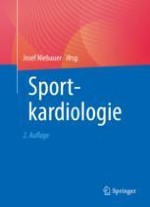Zusammenfassung
Patienten nach LVAD-Implantation benötigen eine intensive interdisziplinäre Betreuung und Überwachung zur Vermeidung und Behandlung von Device-spezifischen Komplikationen. Die wissenschaftliche Evidenz ist nicht ausreichend, um Guidelines für das Training von LVAD-Patienten zu erstellen, jedoch sprechen die vorhandenen Daten dafür, dass es mit Steuerung der Intensität nach der BORG-Skala, wie auch bei Patienten nach Herztransplantation, sicher und erfolgreich durchgeführt werden kann. In Zukunft muss geklärt werden, warum es bei manchen Patienten im Langzeitverlauf zu keiner Verbesserung der Leistungsfähigkeit kommt. Bei entsprechenden Umfängen und Intensitäten sind, vergleichbar mit gesunden Athleten, auch transplantierte Herzen trainierbar. Der Schwerpunkt des rehabilitativen Trainings nach einer Herztransplantation liegt aber eindeutig in der Adaptation der Skelettmuskulatur.











